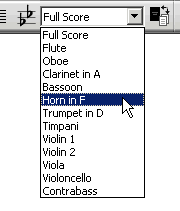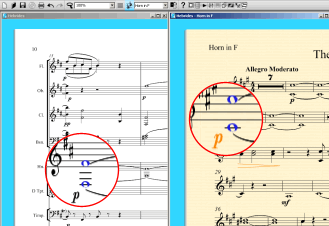Dynamic Parts™ in Sibelius 4
These pages refer solely to the upgrade from Sibelius 1.x, 2.x and 3.x to Sibelius 4. All the improvements and many more are incorporated in the more recent upgrade to Sibelius 6.
 Imagine what it would be like if you never
had to extract parts again.
Imagine what it would be like if you never
had to extract parts again.
Part extraction may save a lot of time, but it’s not instant – you still have to check the parts and clean them up. And if you revise the score later, you either have to spend ages making the same revisions in the parts, or extract them all over again.
So… what would it be like if parts were somehow already there as soon as you started a score, beautifully laid out. And they magically updated themselves whenever you changed the music?
Sounds like we’re dreaming? No – welcome to Dynamic Parts!
![]() Watch movie (Flash, 2.6M)
Watch movie (Flash, 2.6M)
“With 15 minutes left, and parts for three full orchestral arrangements to be revised and printed, Dynamic Parts saved me with time to spare!”
David O'Rourke, arranger & educator
What's it all about?
In Sibelius 4, you don't have to do anything to get parts. As soon as you start a new score, all the parts are already there – you can choose any of them from a list on the toolbar. As you add music to the full score, it appears in the relevant parts too. In fact, whatever you do to the score, Sibelius instantly updates the parts. Or you can change the parts, and the score will change to match!
What's more, all the parts are kept in the same file as the score – so they're easier to organize, too.

Changing notes in the score on the left changes the transposed Horn part, too.
You can also adjust things in the part without affecting the score (shown in orange)
Differences in parts
Sometimes you need to change things just in a part rather than the score – such as nudging text, adding cues, or altering page turns. Again, Sibelius 4 takes care of all this: you can move objects and alter the layout in parts without changing the score – useful when making final adjustments. And you can make things like cues appear in a part but not the score, and vice versa.
More handy features
Dynamic Parts saves you time in other ways, too. No need to print each part separately – a single mouse-click now prints a complete set of parts. You can even specify how many copies you want for each instrument.

Printing a complete set of parts
You can copy the layout between parts; so if the brass instruments have roughly similar parts, just ensure one of them is laid out how you want it, then copy the entire layout to the other brass parts with a couple of clicks.
You can still extract parts into separate files if you want to, but there's rarely any need.
Overall, Dynamic Parts will save you hours of work on every score – all the time spent extracting and revising individual parts is now a thing of the past.
Auto Layout™
Auto Layout is a new feature that lays parts out even better than before. In fact, we've tried to make it so that you'll hardly need to adjust parts at all – just a quick look through and then print.
Auto Layout puts rehearsal marks, tempo text, double barlines, key changes and long multirests at the start of systems where possible, to make them easier for players to locate. The top staff is moved down to allow room for the title, and you can indent the staff too. You can set a fixed number of bars per system, which is now maintained even if you insert or delete bars.
Long multirests are drawn wider than short ones, and silent sections can be written as TACET automatically. Sibelius 4 can also split multirests into (say) 8-bar phrases, or every 10 bars, to aid counting.
Auto page breaks are also improved; for example, Sibelius now ends the page at the longest available rest, to allow the player more time to turn.
But Auto Layout isn't just for parts - you can use any of these features in scores as well.
Quick links
Take a tour
A comprehensive guide to the new features


